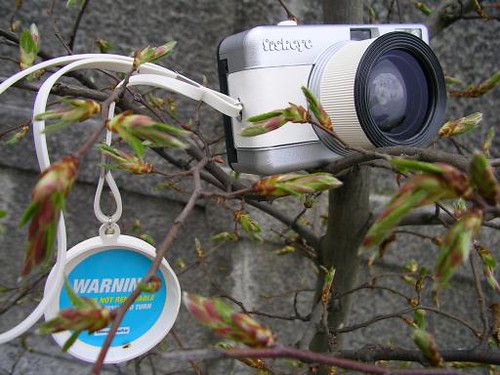Lomography

|
| Lomography Fisheye Camera image by Uwe Kulick (Image rights) |
Lomography is a registered trademark of Lomographische AG (Austria). The Lomography Society International promotes the use of playful and "lo-fi" cameras. The first of these cameras, which lent the society its name, was a copy of the of the Cosina CX-2 sold by Lomo of St. Petersburg, Russia: the LC-A. Since then, many whimsical and intentionally-flawed cameras have been promoted, along with a "shoot from the hip" aesthetic. Viewed as either a modern impressionistic art movement, or a simple (and effective) marketing ploy, Lomography has attracted a large international following around its "10 rules" given below.
As old stocks of the Lomo LC-A and other Russian Lomo products dwindled, LSI increasingly began commissioning its own original designs. Many of these relate somehow to historical cameras, such as their Chinese-built clone of the LC-A, the LC-A+, or the Diana Plus, a recreation of the 1960s-1970s Hong Kong Diana.
While Lomography images are often presented as having particularly intense, offbeat colors, this is generally a result of cross processing the film rather than being an inherent quality of any particular camera or lens.
Contents
Lomography's 10 "Rules"
- Take your camera everywhere you go.
- Use it anytime - day or night.
- Lomography is not an interference in your life, but a part of it.
- Shoot from the hip.
- Approach the objects of your Lomographic desire as close as possible.
- Don't think. (William Firebrace)
- Be fast.
- You don't have to know beforehand what you've captured on film.
- You don't have to know afterwards, either.
- Don't worry about any rules.
The photographic results of "Lomography"
Subjects
Everyday people, colorful objects, and unusual or surreal situations and people are just a few examples of common lomographic subjects.
Focus
Many lomography cameras have unpredictable lens coverage, and due to the plastic lens on almost all Lomography cameras, sharp focus is uncommon. Every lens is a little bit different.
Degraded edges
Vignetting is most pronounced with the use of medium format film on a 12 shot setting without the use of a frame mask, e.g. when using the Diana Plus.
Unexpected Colors and Effects
Probably the most noticeable aspect of lomography is the unexpected and widely varying exposure, random lens flashes, light leaks, and intentional or unintentional double exposures. Although achieving these effects is undesirable in traditional photography, they are the entire goal of Lomography.
Viral marketing
As this movement was created and is run by the "Lomographic Society", who are the sole authorized importer of LOMO products in the West, many have suggested that the Lomographic movement was started as a viral marketing campaign. The Lomographic Society was able to increase the demand for its products by creating an identity group whose members would more-or-less automatically become paying customers. This increased demand led to increased prices. The LOMO LC-A, for example, would cost about $30 US in the former Soviet Union. If bought through the Lomographic Society, the same camera would cost $200 US. Judged in terms of profit and generated hype, this marketing campaign has been very effective.
Cameras sold by Lomography

|
| Lomography Diana shop window display image by AWCam (Image rights) |
In addition to the cameras made by the LOMO factory, Lomographic also sells other cameras:
- Lomography Diana Plus
- Lomography Diana F+
- Lomography Diana Mini
- Diana Baby 110
- Lomography Konstruktor
- Lomography Konstruktor F
- Lomography La Sardina
- Lomography Lomo'Instant
- Lomography Lomo'Instant Wide
- Lomography LOMO LC-A+
- Lomography LOMO LC-Wide
- Lomography LC-A 120
- Lomography LOMOKINO
- Lomographic ActionSampler (and Flash model)
- Lomography Belair X 6-12 (6x12 AE panorama folder)
- Lomographic Colorsplash Camera
- Lomographic Fisheye Camera
- Lomographic Frogeye Underwater
- Lomographic Oktomat
- Lomographic Pop9
- Lomographic SuperSampler
- Lomolitos Single Use
- Lomographic Spinner Dolphin 360° / Lomographic Spinner 360°
- Lomography Sprocket Rocket
- Polaroid Spectra Blitz
Film
- Lomography 100/400/800 Color film
- Lomography Earl Grey B&W 100 ISO film
- Lomography Lady Grey B&W 400 ISO film
- Lomography Redscale 50-200 ISO film
- Lomography Redscale 100 film
- Lomography Orca 100 ISO B&W 110 Pocket film
- Lomography Tiger 200 ISO Color 110 Pocket film
- Lomography Peacock X-Pro 200 ISO 110 Pocket film
- Lomography Lobster Redscale 200 ISO 110 Pocket film
- Lomography X-Pro 200 ISO film
- Lomochrome Purple
- Lomochrome Turquoise
Links
- Lomographic Society International
- Flickr Lomography Group
- Lomography News (archived)
- Why I don't like Lomography, from Alfred Klomp's camera site
- Emulating the Lomo effect in Gimp
- Emulating the Lomo effect in Photoshop